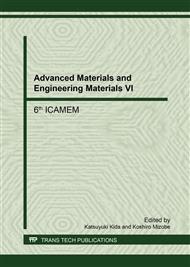p.341
p.346
p.353
p.358
p.363
p.369
p.375
p.381
p.386
Study on Methane Adsorption Capacity of Sensor Probe Based on Lead-Free Piezoelectric Resonance Modified by Zeolite X
Abstract:
The preparation and adsorption capacity of a methane based sensor probe based on lead-free piezoelectric resonance ceramics were investigated in this paper. The zeolite X which synthesized via hydro-thermal process was used to modify the sensor probe surface. The phase structure and microstructure of the zeolite membranes was examined by X-ray diffraction (XRD) and scanning electron microscopy (SEM).Due to the special crystal structure, the zeolite X molecular contain a regular form, uniform pore, larger surface area and a strong surface polarity. In order to test the sensor probe sensitivity, the impedance spectrum of methane adsorption sensitivity was measured at a methane concentration range from 0 to 5%. The results indicate that the sensor probe exhibits enhanced sensitivity with an offset resonant frequency of 590Hz especially at the lower methane concentration found in coal mining. The sensitivity can reach 165 Hz/1% CH4 at the concentration of methanol below 3%. With further increase of methane concentration from 3% to 5%, the sensitivity of sensor probe dropped slightly to 120Hz/1% CH4.
Info:
Periodical:
Pages:
363-368
Citation:
Online since:
August 2017
Authors:
Price:
Сopyright:
© 2017 Trans Tech Publications Ltd. All Rights Reserved
Share:
Citation:


